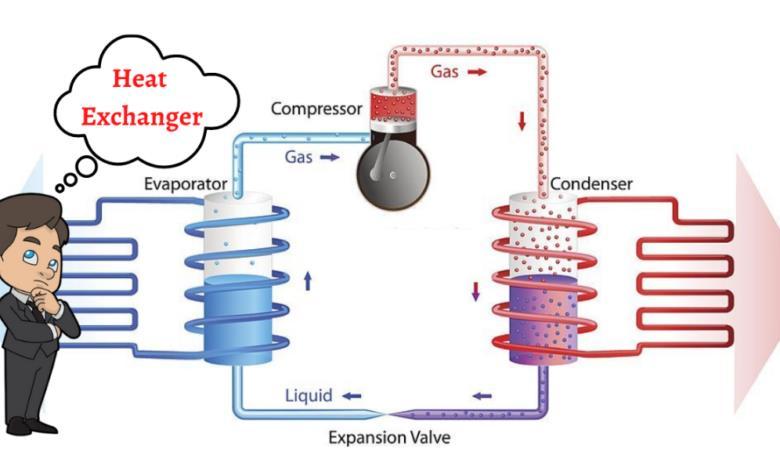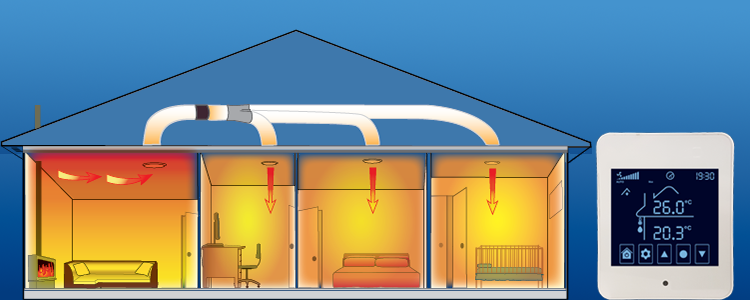DVS Heat Transfer Systems in Detroit: How Local Industries Are Innovating Heat Transfer Solutions
The Duty of Heat Transfer Equipments in Sustainable Energy Solutions for the Future
Heat transfer systems are crucial in the pursuit for lasting power remedies. They maximize thermal energy administration, enhancing the performance of renewable technologies. By utilizing devices like radiation, conduction, and convection, these systems reduce power losses. Their function in solar thermal and geothermal applications is especially significant. As developments emerge, the capacity for additional advancements elevates crucial inquiries concerning future power methods. What growths will form the landscape of sustainable power?
Understanding Heat Transfer Solutions

The Value of Thermal Power Management
Effective thermal power monitoring is crucial for making best use of energy effectiveness and decreasing waste in different systems. By controling temperature level and maximizing Heat transfer procedures, companies can significantly lower power consumption and operational costs. Effective monitoring includes the implementation of sophisticated technologies and methods that keep track of and regulate thermal problems within systems, making sure that power sources are utilized efficiently. Additionally, appropriate thermal energy administration adds to lowering greenhouse gas exhausts, straightening with global sustainability objectives. It also improves system integrity and performance, resulting in boosted item top quality and longer devices life expectancy. Ultimately, prioritizing thermal energy monitoring is a vital step towards creating extra lasting energy options and fostering an accountable approach to energy usage in industrial and property contexts.
Applications of Heat Transfer in Renewable Energy
While numerous renewable resource sources assure sustainability, the efficient application of Heat transfer plays a crucial role in their effectiveness. In wind energy systems, Heat transfer is made use of for wind turbine part air conditioning, enhancing performance and durability. Geothermal energy depends on reliable Heat exchange between the earth's subsurface and the liquid flowing in the system, optimizing energy extraction. Biomass power procedures likewise profit from Heat transfer, as it aids in transforming organic products right into functional fuel through pyrolysis and gasification. Furthermore, in hydropower, maintaining suitable temperature levels in tanks can enhance power output. Each of these applications shows the essential value of Heat transfer systems in enhancing eco-friendly energy modern technologies, inevitably adding to a much more sustainable energy future.
Enhancing Solar Thermal Power Performance
As solar thermal power systems remain to progress, boosting their performance has come to be crucial for taking full advantage of power outcome. Advances in Heat transfer modern technologies, such as enhanced thermal storage products and innovative Heat exchangers, play a significant role in enhancing performance. By utilizing innovative materials that have superior thermal conductivity, systems can transfer and catch Heat better. Additionally, integrating radar that follow the sun's course guarantees that collectors get suitable solar exposure throughout the day. Making use of nanotechnology in solar absorbers can even more boost power absorption rates. Moreover, incorporating automated control systems helps regulate temperature levels and handle energy distribution effectively, leading to lowered losses and improved total system efficiency. These enhancements pave the method for more sustainable solar thermal power remedies in the future.
Geothermal Home Heating: A Sustainable Option
Geothermal heating presents a sensible choice for sustainable power, offering significant environmental advantages through reduced greenhouse gas discharges. Its performance and cost-effectiveness make it an appealing alternative to typical heating unit. Difficulties associated to application must be resolved to maximize its potential effect.
Environmental Benefits of Geothermal
Although typical heating techniques contribute substantially to greenhouse gas exhausts, geothermal heating provides a compelling choice that lessens environmental influence. By utilizing the Earth's inner Heat, geothermal systems utilize a renewable resource source, significantly lowering dependence on nonrenewable fuel sources. This approach creates very little carbon discharges, making it a cleaner choice for industrial and residential heating. In addition, geothermal systems advertise power efficiency, as they call for less power compared to traditional furnace. DVS Heat Transfer Systems. The utilization of geothermal power additionally aids in lowering air pollution, boosting local air high quality and public health and wellness. As a lasting option, geothermal heating sustains climate modification mitigation initiatives, positioning itself as a crucial element in the shift towards a greener future
Efficiency and Cost-Effectiveness
Just how does geothermal heating gauge up in terms of performance and cost-effectiveness contrasted to typical heating unit? Geothermal home heating demonstrates exceptional efficiency, often achieving a coefficient of efficiency (COP) of 3 to 5, indicating it produces three to 5 devices of Heat for every system of power eaten. This performance converts right into lower operating expense, specifically in areas with stable geothermal sources. Preliminary installation costs can be greater than conventional systems; nevertheless, long-term cost savings on power bills and lowered maintenance costs can offset try this these ahead of time investments. Additionally, many federal governments incentivize geothermal systems with discounts and tax obligation credit ratings, improving their cost-effectiveness. Generally, geothermal home heating arises as a financially sensible and sustainable option to even more traditional heating solutions.
Implementation Obstacles and Solutions
Various obstacles can hamper the extensive implementation of geothermal heater, in spite of their clear benefits as a lasting energy option. High preliminary installation expenses commonly hinder homeowners and financiers, making useful site financing a substantial obstacle. Furthermore, the geographical limitations of appropriate geothermal sites limit ease of access in particular regions. Regional policies and allowing processes can likewise make complex project development, bring about hold-ups. Moreover, public awareness and understanding of geothermal systems remain low, impeding acceptance. To deal with these difficulties, targeted education campaigns can enhance public understanding, while government rewards could alleviate economic worries. Teaming up with local authorities to simplify laws may assist in smoother task authorizations, eventually promoting the fostering of geothermal home heating as a feasible, lasting power choice.
Developments in Heat Transfer Technologies
Technologies in Heat transfer modern technologies play a crucial duty in improving power performance and sustainability. Advanced Heat exchangers and phase modification materials are at the forefront of these advancements, providing substantial renovations in thermal management. These innovations not just optimize power usage but also contribute to minimizing ecological effect in different applications.
Advanced Heat Exchangers
Advanced Heat exchangers play an essential role in enhancing energy effectiveness throughout various applications in lasting energy services. These tools help with the transfer of Heat in between 2 or even more liquids, considerably minimizing energy consumption in processes such as commercial heating, cooling, and power generation. Technologies in materials and style, such as the use of nanofluids and compact setups, have actually led to improved thermal performance and lowered dimension requirements. In addition, improvements in digital tracking and control systems enable maximized procedure, additional boosting efficiency. By lessening waste Heat and maximizing power healing, progressed Heat exchangers contribute to decrease carbon footprints and sustain the shift toward eco-friendly innovations. Their continued development is important for accomplishing worldwide power sustainability goals.
Phase Modification Materials
The combination of phase adjustment materials (PCMs) right into Heat transfer innovations their website stands for a significant improvement in power monitoring and performance. PCMs absorb and release thermal energy during their stage adjustments, enabling efficient temperature level law in structure products and energy systems. By saving excess Heat during peak periods and launching it when demand increases, PCMs add to pack moving and energy preservation - DVS Heat Transfer Systems. This capability enhances the performance of renewable resource systems, specifically in solar thermal applications. Additionally, PCMs can boost the thermal convenience of interior environments, reducing dependence on traditional home heating and cooling down techniques. As innovations in PCM formulas proceed to arise, their duty in lasting power services is poised to expand, supplying appealing methods for future research and application

Future Leads for Heat Transfer in Sustainable Energy
As the demand for sustainable power remedies proceeds to climb, the duty of Heat transfer systems is becoming significantly crucial in shaping future technologies. Advancements in materials and designs are expected to enhance effectiveness in Heat transfer, minimizing power losses in numerous applications. The assimilation of advanced thermal storage systems, such as stage modification materials and thermochemical storage space, will certainly allow much better management of energy sources. Study into nanofluids and biomimetic Heat exchangers might even more optimize thermal efficiency. Additionally, the adoption of clever modern technologies will enable real-time surveillance and adaptive control of Heat transfer procedures. These improvements are positioned to significantly contribute to the overall effectiveness and sustainability of power systems, paving the means for a more energy-efficient future.
Often Asked Inquiries
Exactly How Can People Carry Out Heat Transfer Solution in your home?

Individuals can implement Heat transfer systems at home by mounting energy-efficient home appliances, using radiant heat, and maximizing insulation. These measures improve energy effectiveness, lower expenses, and advertise lasting methods in property settings.

What Are the Expenses Linked With Setting Up Heat Transfer Solutions?
The expenses related to mounting Heat transfer systems vary widely, normally including equipment, installment labor, and upkeep. Aspects such as system kind, home dimension, and local laws substantially influence the total expense included.
Are There Government Rewards for Heat Transfer System Installations?
Federal government motivations for Heat transfer system installations vary by area and can consist of tax credit ratings, rebates, and gives. These economic advantages intend to encourage fostering, inevitably advertising power efficiency and minimizing environmental impact within areas.
How Do Heat Transfer Solutions Impact Power Expenses?
Heat transfer systems especially affect energy bills by optimizing power efficiency. By boosting the transfer of Heat, these systems minimize energy intake, leading to reduced utility costs and creating an extra sustainable method to energy administration.
What Upkeep Is Required for Heat Transfer Equipments?
Upkeep for Heat transfer systems consists of regular evaluations, cleansing of parts, examining fluid degrees, making sure correct insulation, and changing used parts. These tasks assist maintain effectiveness, protect against breakdowns, and extend the system's functional life-span.
These systems help with the movement of thermal energy from one medium to another, making it possible for the transfer of Heat for air conditioning, home heating, or power generation objectives. Geothermal energy counts on reliable Heat exchange between the earth's subsurface and the fluid flowing in the system, making the most of power extraction. Furthermore, geothermal systems promote power effectiveness, as they require less power compared to traditional heating systems. Advanced Heat exchangers play a crucial role in improving power performance across numerous applications in sustainable power services. Heat transfer systems significantly influence energy bills by maximizing power efficiency.